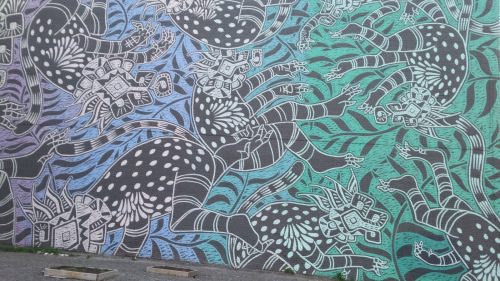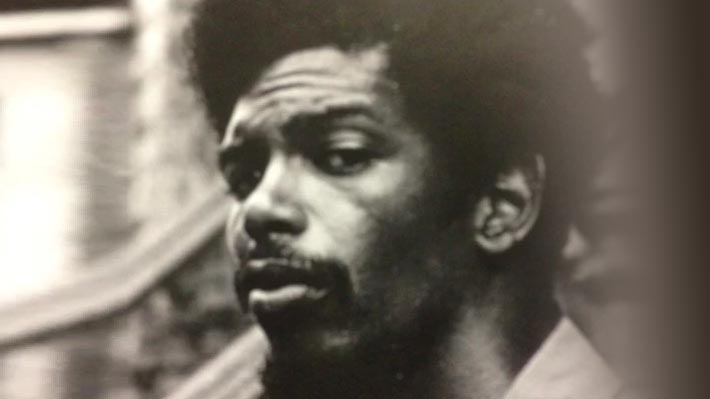
(Photo by Rana Bose)
A eureka moment happens once in a while. But given our irreversible physical decline, we must opt not to run naked down the street, as the discoverer of buoyancy once did. In any case, the potential for embarrassing our watchful neighbours remains a deterrent.
A few weeks ago, as I walked down the immaculately paved blocks in one neighbourhood, the eureka moment happened. I stopped short and looked straight ahead. A run-naked-down-the-street moment had arrived and I had frozen to a halt, mesmerized by the uniformity of the rectangular concrete slabs and the refractory effect on my vision. I realized that my steps were controlled without my acquiescence. I was stepping in line to the equally spaced cement blocks under my feet. In a borough where houses are equally spaced and uniformity or congruence is promulgated by the city’s no-nonsense facade enforcers, I realized how the pavements, houses and the spaces in between have shaped our physical behaviour as well as our political and philosophical discourse, and vice versa. I am sure the rectilinear approach to town planning originates in the logic of linear assembly lines and in turn generates a craving for order and sequential behaviour. When I go to another, less endowed neighbourhood of my very liveable city, I find that the balconies are sometimes precariously inclined, the alleys are like war zones, the pavements are cracked, often missing large sections, quickly patched up with ungainly heaps of tar. I also know that in these neighbourhoods, most folks do not have dental coverage, do not always bow politely as you pass them on the sidewalk, and do not care to stand in a line at the dépanneur. They remind me of where I came from. They let me know that where there is uniformity, there is order and compliance and if per chance there is some break, some discord may happen. Where there is un-uniformity, the potential for discord lurks. A perverse type of extreme rationalization, the logic of the “supply curve meets the demand curve,” and the drive for absolute utilization and control necessitates that every space should be defined, made orderly and also manageable.
Like worms in the soil, we love to slide and wriggle down this wonderful rectilinear cement-way of uniformity. We like space, we like neatness, we like equal distance on each concrete slab and we are proud to have sidewalks that slope gently down at the corners and provide friction-inducing slats for the disabled to gently roll down in their electric wheel chairs, coffee mugs in hand. Water, gas, cable, telephone, fibreglass lines are flagged discretely on the ground with little spray-painted identifiers in regular intervals. We assign moral superiority to our existence here in this remarkably rectilinear sense of organization. We care for each other, or at least that is what we radiate with every breath we exhale. It is a civilizing, relaxing Zen state we have achieved. We like order as an aesthetic. As I walk down the rectangular blocks of uniformity, there is something in me that feels itchy. For some disorder, some divergence, disparity, some disconnection. There is none. This neighbourhood will not tolerate it! I am not looking for poor workmanship, cracked pavements, lack of quality assurance or sink holes and stress cracks. Those are another issue. I am looking for loss of rectilinearity. I cannot find any. I can see straight ahead, two blocks away. Through the trees that don’t have leaves at this time of the year. And I see unending straightness. The streets don’t curve. Block after block. As far as I can see. A master plan based on a certain consensus has occurred here!
There are advanced digital GPS-based theodolites that have measured angles, vertical and horizontal, and brought absolute order. Even on occasions when I travel to the suburbs of this city, the crescents are, as well, theodolite-controlled, curved but manicured. It seems even every blade of grass in the park in the middle of the crescent sways in the same direction, as if the energy of the wind were measured to tilt the blades of grass away in a quantified azimuthal direction. A carefully placed bench under a tree is painted every summer by dissatisfied-looking young students, hired by the borough. Such is the love of order and aesthetics in this society. Chaos is forbidden or painted over. Green. Weedery is impermissible.
I came forty-five years ago from a city where pavements were irregular or non-existent, not a single street was rectilinear, the spaces between houses were practically non-existent, the concept of heritage preservation was barely nascent, green spaces between houses were unknown, and sound insularity between neighbours was an absurd assault on common sense. We could see everyone, always on the streets or balconies; horns blared and people shouted across verandas to people across the street. Streets were curved, cracked, distorted, and in fact my favourite street name was Serpentine Lane. Being a tropical nation, windows were left open, wrought iron balconies had their doors open always and noise levels were acceptable – well above 120 decibels at any time of the night, never mind the day. Ambulance sirens meant nothing. The dead were on their way out. Why delay the inevitable?
In effect, we were comfortable with lack of distance, inadequate private space; we were used to a certain dis-empathy and lack of order and very much comfortable with chaos as standard. Indiscipline and lack of linearity fortified us. We jumped queues as standard operating procedure. We crowded around counters instead of waiting in line. The concept of “taking a number” was alien. The notion of individual rights and responsibilities was usurped or sneered at because of pride in community, collective and national priorities. After all, overcoming colonial occupation and looting, and the restoration of national wealth and access to a threadbare existence were significantly more important than sound levels in the city, heritage architecture and “waiting your turn.” I also eventually learned, by my sheer act of migration, that democracy as understood by advanced industrialized states was groomed by universalisms that did not have to comprehend the particularisms of neo-colonies and pre-industrial states. Issues of tribe, clan, caste, cultural behaviour and indigenous rituals had no meaning for the logistical layout of cities.
I learned further, in the past few decades, that the same industrialized societies had to advance to post- industrialized societies (by a predatory logic inherent to it) where the chase to advance the bottom line had predicated that technology be exploited to the hilt; basic and commodity skills were no longer necessary, and our societies had to satisfy themselves with temporary skills, changing skills, temporary lives and temporary cities.
Of course, things are changing, and the world is definitely becoming a flatter place when it comes to behavioural norms. In China, railway stations are an example of industrial orderliness through colour- coded LED screens. Everything is digitized. People, laughing and weChatting, move to their respective marked-up lanes on railway platforms, based on colour-coded signals on LED screens. When the train is 5 kilometres away, the lights switch from amber to green, advising the passengers to move to their designated line-up lanes. In China, trains are often hurtling through at 400 km/hour on magnetic levitation technology. So order and timeliness are on the cards! It is not regimentation, as some would opinionate, but digitized automation that channels democratic respect for the space and priority of the one next to you.

Street art by Curiot (Photo by Jody Freeman)
But therein lies the point of departure. What is the philosophy of democracy in pre-industrial, industrial and post-industrial societies? Those who were born in a rectilinear, theodolite-controlled democracy have a somewhat aloof but superior sense of human rights and responsibilities. I am talking about the European experience of social development, of industrial and social revolutions. And that includes North America, where cities were developed (with theodolites!) in virgin territories, beyond the control of agricultural barons. As such, here we are insistent upon universalizing our notions as the common ethical and moral standard. There is only one standard for what constitutes rights. Because here, the other issues of social development like colonial displacement, feudal land control and sharecropping, easy access to public toilettes, warehousing and food distribution, clean air and water for our children, comfortable public transportation, education that does not blatantly discriminate based on tribe, caste and skin colour, and sewage and garbage-disposal systems that work mostly in a clockwork manner have all facilitated a sense of uniform calm and order. And thereby, other forms of eking out a living and surviving are no longer central themes of discord. Indigenous people have been shoved out of sight and those who meander around subways are herded away by making the space hostile to them, especially in winter. Gentrification converts poor neighbourhoods to suit the needs of people who no longer cook at home, and yet they need nice pavements to walk on and lounge in cafes that extend onto the pavement. The issue now is rectilinear pavements, distance, space and a non-jostling civility. So our sense of democratic debate is now heavily centred on opinions, fake and real news, rumour massaging, content verification, fact checking and control of emissions from wood fireplaces in city neighbourhoods that have their own competing mayoralties. In India, fake eggs are a bigger news item. Yes, they found fake plastic eggs in a carton of six. So, fake eggs versus fake news – that is the delta between linear and non-linear settlements.
I am satisfied, therefore, to have arrived at a eureka moment of realization about the roots of our democracy, but I will not run down the streets naked, because unlike in the time of Archimedes, there are neighbours and community watchdogs watching out for correctness in public behaviour. I am resigned to the notion that chaos, lack of privacy, green spaces and civil rights cannot be so bothersome in pre-industrial societies. There, rights are of a constitutional nature – meaning the constitution of the body. The biology of existence. The failure of the food chain and the artificial famines. Here, in the theodolite world, rights are of a constitutional nature – meaning the constitution that defines the principles of governance. And that includes amendments to the constitution that undermine those very rights, all too often. So, as we evolve, the notion of rectilinearity, order and livelihood necessitates that we get comfortable with temporary notions of existence.










